JEEP RENEGADE 2014 1.G Owners Manual
Manufacturer: JEEP, Model Year: 2014, Model line: RENEGADE, Model: JEEP RENEGADE 2014 1.GPages: 212, PDF Size: 17.48 MB
Page 91 of 212
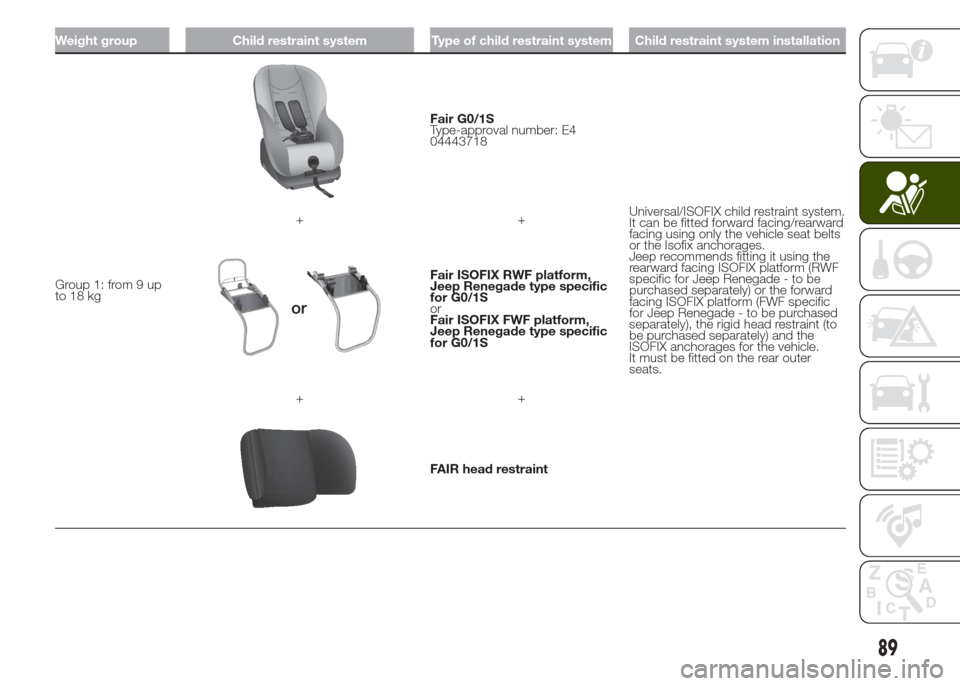
Weight group Child restraint system Type of child restraint system Child restraint system installation
Group 1: from 9 up
to 18 kg
Fair G0/1S
Type-approval number: E4
04443718
Universal/ISOFIX child restraint system.
It can be fitted forward facing/rearward
facing using only the vehicle seat belts
or the Isofix anchorages.
Jeep recommends fitting it using the
rearward facing ISOFIX platform (RWF
specific for Jeep Renegade - to be
purchased separately) or the forward
facing ISOFIX platform (FWF specific
for Jeep Renegade - to be purchased
separately), the rigid head restraint (to
be purchased separately) and the
ISOFIX anchorages for the vehicle.
It must be fitted on the rear outer
seats. ++
Fair ISOFIX RWF platform,
Jeep Renegade type specific
for G0/1S
or
Fair ISOFIX FWF platform,
Jeep Renegade type specific
for G0/1S
++
FAIR head restraint
89
Page 92 of 212
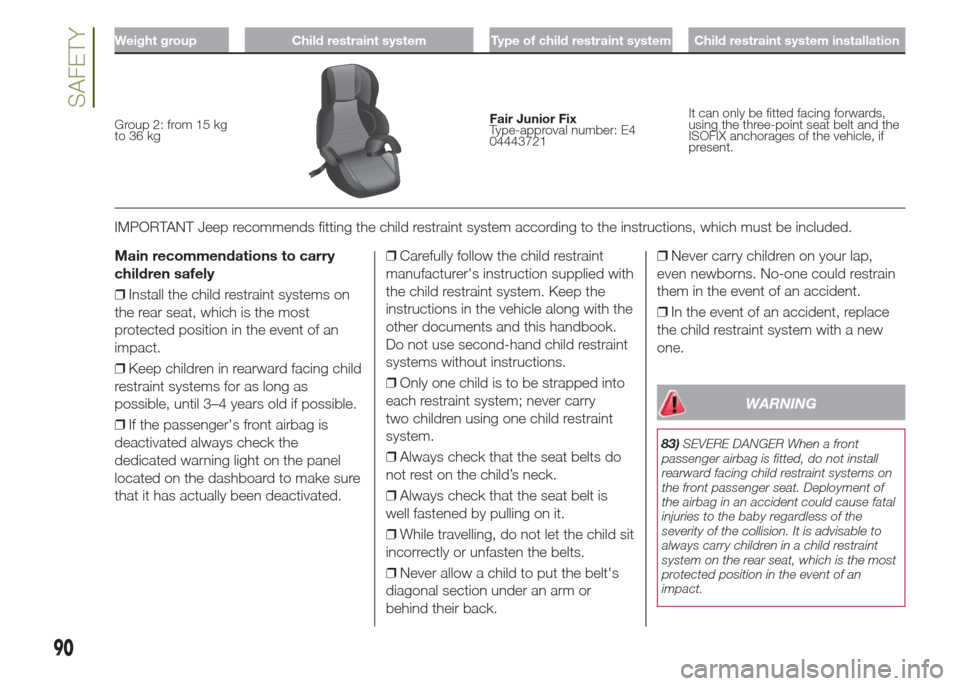
Weight group Child restraint system Type of child restraint system Child restraint system installation
Group 2: from 15 kg
to 36 kgFair Junior Fix
Type-approval number: E4
04443721It can only be fitted facing forwards,
using the three-point seat belt and the
ISOFIX anchorages of the vehicle, if
present.
IMPORTANT Jeep recommends fitting the child restraint system according to the instructions, which must be included.
Main recommendations to carry
children safely
❒Install the child restraint systems on
the rear seat, which is the most
protected position in the event of an
impact.
❒Keep children in rearward facing child
restraint systems for as long as
possible, until 3–4 years old if possible.
❒If the passenger's front airbag is
deactivated always check the
dedicated warning light on the panel
located on the dashboard to make sure
that it has actually been deactivated.❒Carefully follow the child restraint
manufacturer's instruction supplied with
the child restraint system. Keep the
instructions in the vehicle along with the
other documents and this handbook.
Do not use second-hand child restraint
systems without instructions.
❒Only one child is to be strapped into
each restraint system; never carry
two children using one child restraint
system.
❒Always check that the seat belts do
not rest on the child’s neck.
❒Always check that the seat belt is
well fastened by pulling on it.
❒While travelling, do not let the child sit
incorrectly or unfasten the belts.
❒Never allow a child to put the belt's
diagonal section under an arm or
behind their back.❒Never carry children on your lap,
even newborns. No-one could restrain
them in the event of an accident.
❒In the event of an accident, replace
the child restraint system with a new
one.
WARNING
83)SEVERE DANGER When a front
passenger airbag is fitted, do not install
rearward facing child restraint systems on
the front passenger seat. Deployment of
the airbag in an accident could cause fatal
injuries to the baby regardless of the
severity of the collision. It is advisable to
always carry children in a child restraint
system on the rear seat, which is the most
protected position in the event of an
impact.
90
SAFETY
Page 93 of 212
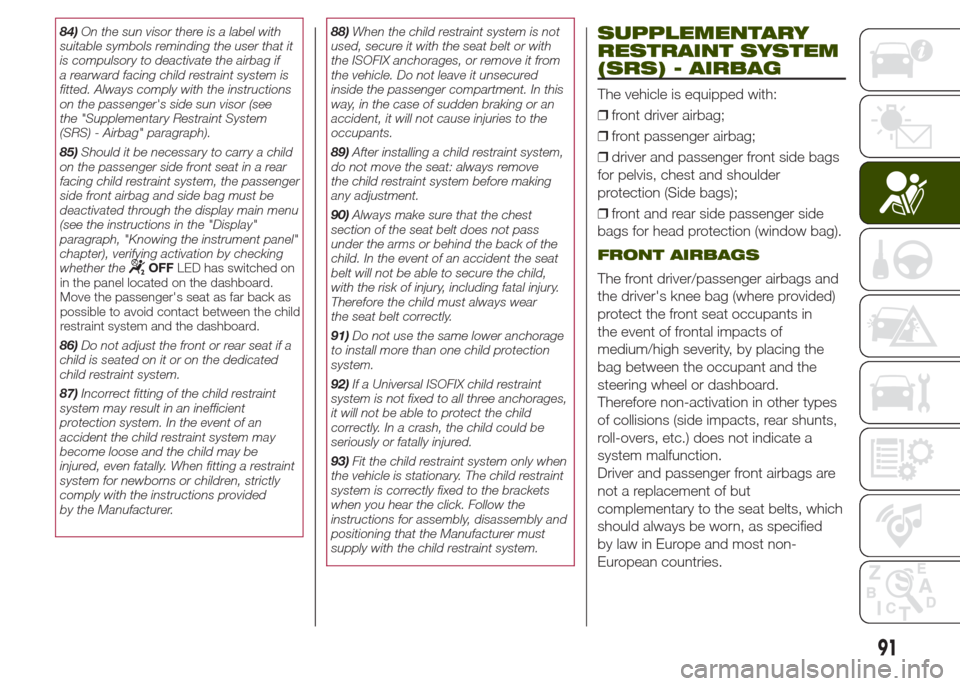
84)On the sun visor there is a label with
suitable symbols reminding the user that it
is compulsory to deactivate the airbag if
a rearward facing child restraint system is
fitted. Always comply with the instructions
on the passenger's side sun visor (see
the "Supplementary Restraint System
(SRS) - Airbag" paragraph).
85)Should it be necessary to carry a child
on the passenger side front seat in a rear
facing child restraint system, the passenger
side front airbag and side bag must be
deactivated through the display main menu
(see the instructions in the "Display"
paragraph, "Knowing the instrument panel"
chapter), verifying activation by checking
whether the
OFFLED has switched on
in the panel located on the dashboard.
Move the passenger's seat as far back as
possible to avoid contact between the child
restraint system and the dashboard.
86)Do not adjust the front or rear seat if a
child is seated on it or on the dedicated
child restraint system.
87)Incorrect fitting of the child restraint
system may result in an inefficient
protection system. In the event of an
accident the child restraint system may
become loose and the child may be
injured, even fatally. When fitting a restraint
system for newborns or children, strictly
comply with the instructions provided
by the Manufacturer.88)When the child restraint system is not
used, secure it with the seat belt or with
the ISOFIX anchorages, or remove it from
the vehicle. Do not leave it unsecured
inside the passenger compartment. In this
way, in the case of sudden braking or an
accident, it will not cause injuries to the
occupants.
89)After installing a child restraint system,
do not move the seat: always remove
the child restraint system before making
any adjustment.
90)Always make sure that the chest
section of the seat belt does not pass
under the arms or behind the back of the
child. In the event of an accident the seat
belt will not be able to secure the child,
with the risk of injury, including fatal injury.
Therefore the child must always wear
the seat belt correctly.
91)Do not use the same lower anchorage
to install more than one child protection
system.
92)If a Universal ISOFIX child restraint
system is not fixed to all three anchorages,
it will not be able to protect the child
correctly. In a crash, the child could be
seriously or fatally injured.
93)Fit the child restraint system only when
the vehicle is stationary. The child restraint
system is correctly fixed to the brackets
when you hear the click. Follow the
instructions for assembly, disassembly and
positioning that the Manufacturer must
supply with the child restraint system.
SUPPLEMENTARY
RESTRAINT SYSTEM
(SRS) - AIRBAG
The vehicle is equipped with:
❒front driver airbag;
❒front passenger airbag;
❒driver and passenger front side bags
for pelvis, chest and shoulder
protection (Side bags);
❒front and rear side passenger side
bags for head protection (window bag).
FRONT AIRBAGS
The front driver/passenger airbags and
the driver's knee bag (where provided)
protect the front seat occupants in
the event of frontal impacts of
medium/high severity, by placing the
bag between the occupant and the
steering wheel or dashboard.
Therefore non-activation in other types
of collisions (side impacts, rear shunts,
roll-overs, etc.) does not indicate a
system malfunction.
Driver and passenger front airbags are
not a replacement of but
complementary to the seat belts, which
should always be worn, as specified
by law in Europe and most non-
European countries.
91
Page 94 of 212
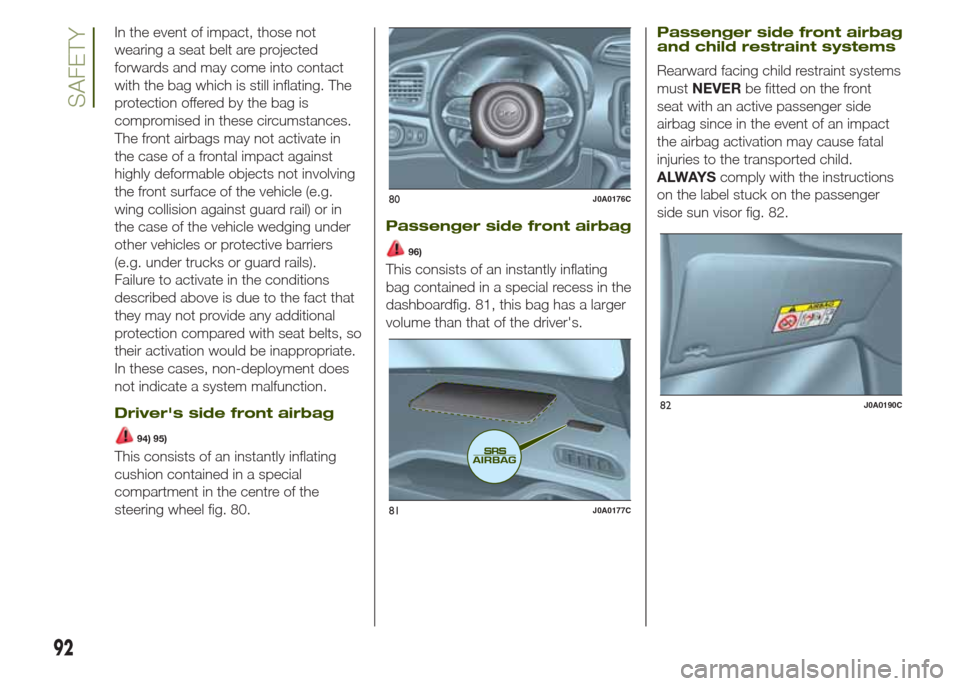
In the event of impact, those not
wearing a seat belt are projected
forwards and may come into contact
with the bag which is still inflating. The
protection offered by the bag is
compromised in these circumstances.
The front airbags may not activate in
the case of a frontal impact against
highly deformable objects not involving
the front surface of the vehicle (e.g.
wing collision against guard rail) or in
the case of the vehicle wedging under
other vehicles or protective barriers
(e.g. under trucks or guard rails).
Failure to activate in the conditions
described above is due to the fact that
they may not provide any additional
protection compared with seat belts, so
their activation would be inappropriate.
In these cases, non-deployment does
not indicate a system malfunction.
Driver's side front airbag
94) 95)
This consists of an instantly inflating
cushion contained in a special
compartment in the centre of the
steering wheel fig. 80.
Passenger side front airbag
96)
This consists of an instantly inflating
bag contained in a special recess in the
dashboardfig. 81, this bag has a larger
volume than that of the driver's.
Passenger side front airbag
and child restraint systems
Rearward facing child restraint systems
mustNEVERbe fitted on the front
seat with an active passenger side
airbag since in the event of an impact
the airbag activation may cause fatal
injuries to the transported child.
ALWAYScomply with the instructions
on the label stuck on the passenger
side sun visor fig. 82.
80J0A0176C
81J0A0177C
82J0A0190C
92
SAFETY
Page 95 of 212
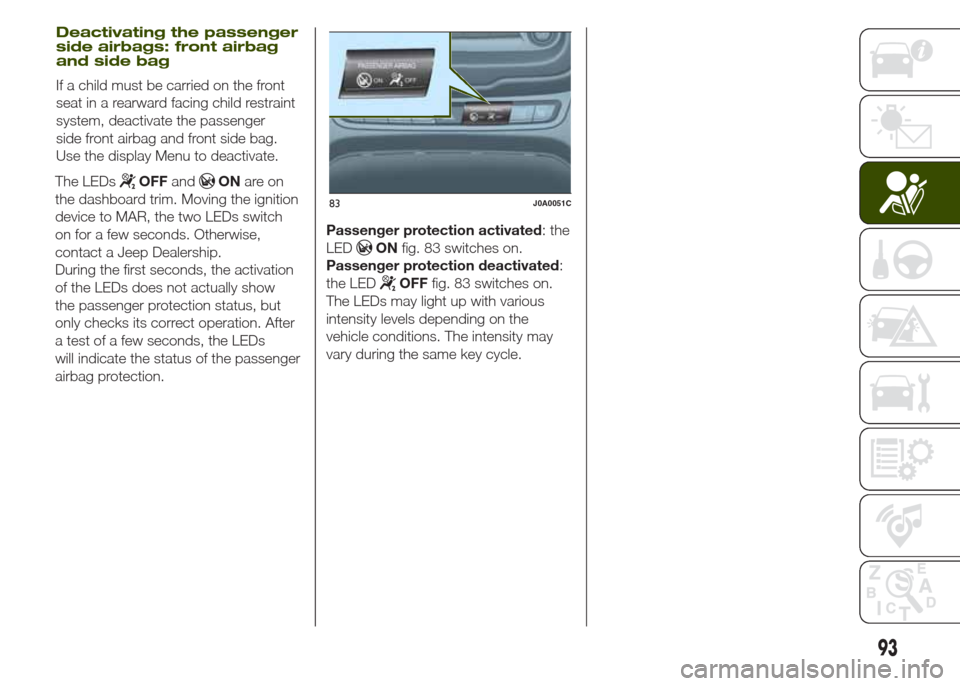
The LEDsOFFandONare on
the dashboard trim. Moving the ignition
device to MAR, the two LEDs switch
on for a few seconds. Otherwise,
contact a Jeep Dealership.
During the first seconds, the activation
of the LEDs does not actually show
the passenger protection status, but
only checks its correct operation. After
a test of a few seconds, the LEDs
will indicate the status of the passenger
airbag protection.Passenger protection activated: the
LED
ONfig. 83 switches on.
Passenger protection deactivated:
the LED
OFFfig. 83 switches on.
The LEDs may light up with various
intensity levels depending on the
vehicle conditions. The intensity may
vary during the same key cycle.
83J0A0051C
93
Deactivating the passenger
side airbags: front airbag
and side bag
If a child must be carried on the front
seat in a rearward facing child restraint
system, deactivate the passenger
side front airbag and front side bag.
Use the display Menu to deactivate.
Page 96 of 212

Passenger front airbag and child restraint system: WARNING
84J0A0215
94
SAFETY
Page 97 of 212
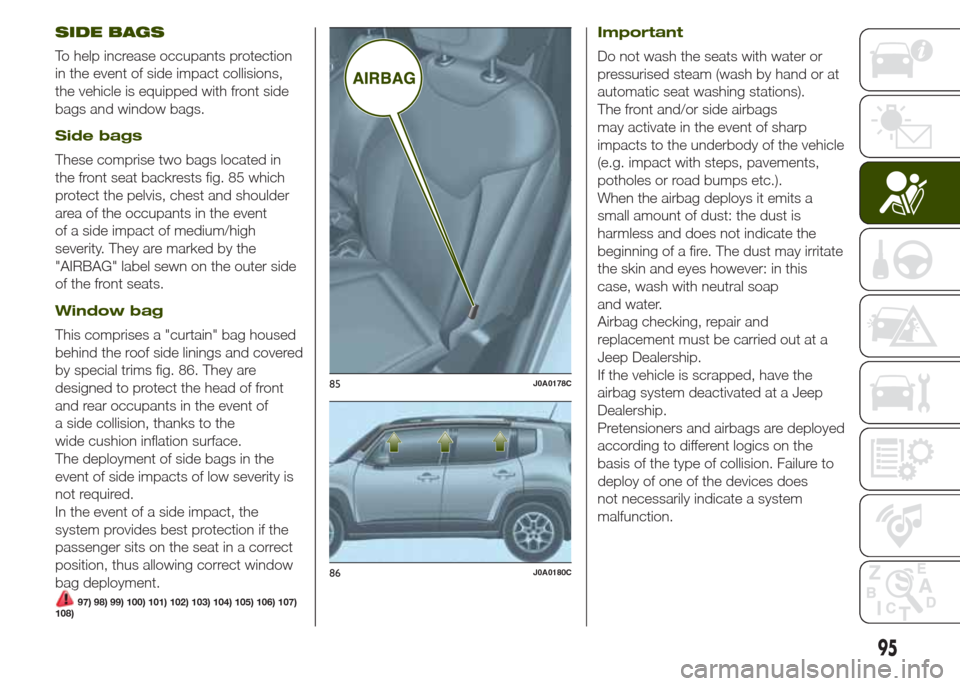
SIDE BAGS
To help increase occupants protection
in the event of side impact collisions,
the vehicle is equipped with front side
bags and window bags.
Side bags
These comprise two bags located in
the front seat backrests fig. 85 which
protect the pelvis, chest and shoulder
area of the occupants in the event
of a side impact of medium/high
severity. They are marked by the
"AIRBAG" label sewn on the outer side
of the front seats.
Window bag
This comprises a "curtain" bag housed
behind the roof side linings and covered
by special trims fig. 86. They are
designed to protect the head of front
and rear occupants in the event of
a side collision, thanks to the
wide cushion inflation surface.
The deployment of side bags in the
event of side impacts of low severity is
not required.
In the event of a side impact, the
system provides best protection if the
passenger sits on the seat in a correct
position, thus allowing correct window
bag deployment.
97) 98) 99) 100) 101) 102) 103) 104) 105) 106) 107)
108)
Important
Do not wash the seats with water or
pressurised steam (wash by hand or at
automatic seat washing stations).
The front and/or side airbags
may activate in the event of sharp
impacts to the underbody of the vehicle
(e.g. impact with steps, pavements,
potholes or road bumps etc.).
When the airbag deploys it emits a
small amount of dust: the dust is
harmless and does not indicate the
beginning of a fire. The dust may irritate
the skin and eyes however: in this
case, wash with neutral soap
and water.
Airbag checking, repair and
replacement must be carried out at a
Jeep Dealership.
If the vehicle is scrapped, have the
airbag system deactivated at a Jeep
Dealership.
Pretensioners and airbags are deployed
according to different logics on the
basis of the type of collision. Failure to
deploy of one of the devices does
not necessarily indicate a system
malfunction.
85J0A0178C
86J0A0180C
95
Page 98 of 212
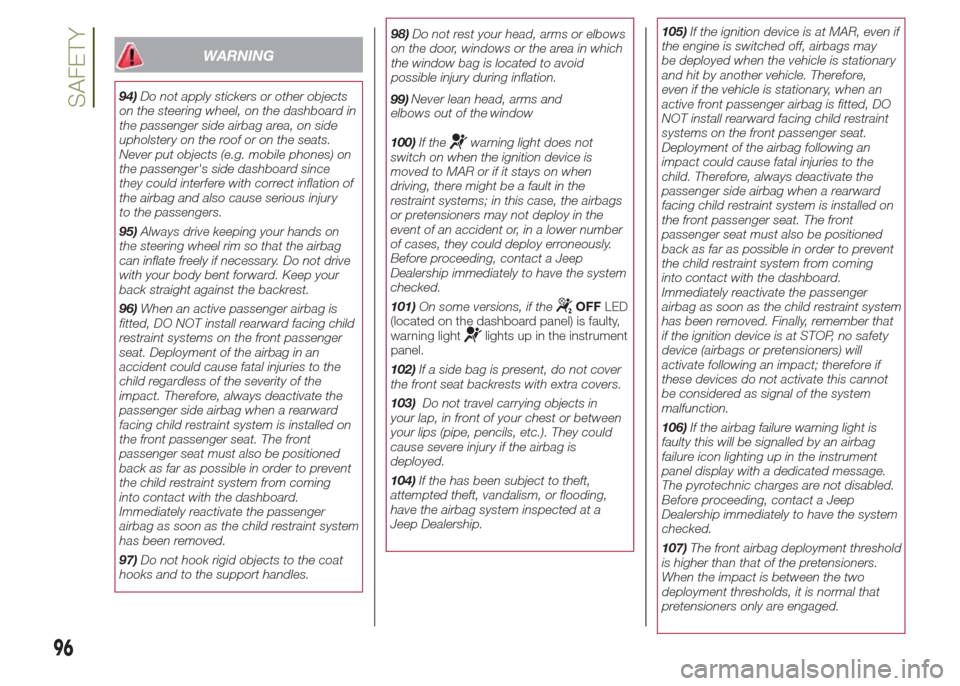
WARNING
94)Do not apply stickers or other objects
on the steering wheel, on the dashboard in
the passenger side airbag area, on side
upholstery on the roof or on the seats.
Never put objects (e.g. mobile phones) on
the passenger's side dashboard since
they could interfere with correct inflation of
the airbag and also cause serious injury
to the passengers.
95)Always drive keeping your hands on
the steering wheel rim so that the airbag
can inflate freely if necessary. Do not drive
with your body bent forward. Keep your
back straight against the backrest.
96)When an active passenger airbag is
fitted, DO NOT install rearward facing child
restraint systems on the front passenger
seat. Deployment of the airbag in an
accident could cause fatal injuries to the
child regardless of the severity of the
impact. Therefore, always deactivate the
passenger side airbag when a rearward
facing child restraint system is installed on
the front passenger seat. The front
passenger seat must also be positioned
back as far as possible in order to prevent
the child restraint system from coming
into contact with the dashboard.
Immediately reactivate the passenger
airbag as soon as the child restraint system
has been removed.
97)Do not hook rigid objects to the coat
hooks and to the support handles.100)If the
warning light does not
switch on when the ignition device is
moved to MAR or if it stays on when
driving, there might be a fault in the
restraint systems; in this case, the airbags
or pretensioners may not deploy in the
event of an accident or, in a lower number
of cases, they could deploy erroneously.
Before proceeding, contact a Jeep
Dealership immediately to have the system
checked.
101)On some versions, if the
OFFLED
(located on the dashboard panel) is faulty,
warning light
lights up in the instrument
panel.
102)If a side bag is present, do not cover
the front seat backrests with extra covers.
103)Do not travel carrying objects in
your lap, in front of your chest or between
your lips (pipe, pencils, etc.). They could
cause severe injury if the airbag is
deployed.
104)If the has been subject to theft,
attempted theft, vandalism, or flooding,
have the airbag system inspected at a
Jeep Dealership.105)If the ignition device is at MAR, even if
the engine is switched off, airbags may
be deployed when the vehicle is stationary
and hit by another vehicle. Therefore,
even if the vehicle is stationary, when an
active front passenger airbag is fitted, DO
NOT install rearward facing child restraint
systems on the front passenger seat.
Deployment of the airbag following an
impact could cause fatal injuries to the
child. Therefore, always deactivate the
passenger side airbag when a rearward
facing child restraint system is installed on
the front passenger seat. The front
passenger seat must also be positioned
back as far as possible in order to prevent
the child restraint system from coming
into contact with the dashboard.
Immediately reactivate the passenger
airbag as soon as the child restraint system
has been removed. Finally, remember that
if the ignition device is at STOP, no safety
device (airbags or pretensioners) will
activate following an impact; therefore if
these devices do not activate this cannot
be considered as signal of the system
malfunction.
106)If the airbag failure warning light is
faulty this will be signalled by an airbag
failure icon lighting up in the instrument
panel display with a dedicated message.
The pyrotechnic charges are not disabled.
Before proceeding, contact a Jeep
Dealership immediately to have the system
checked.
107)The front airbag deployment threshold
is higher than that of the pretensioners.
When the impact is between the two
deployment thresholds, it is normal that
pretensioners only are engaged.
96
SAFETY
98)Do not rest your head, arms or elbows
on the door, windows or the area in which
the window bag is located to avoid
possible injury during inflation.
99)
elbows out of the windowNever lean head, arms and
Page 99 of 212
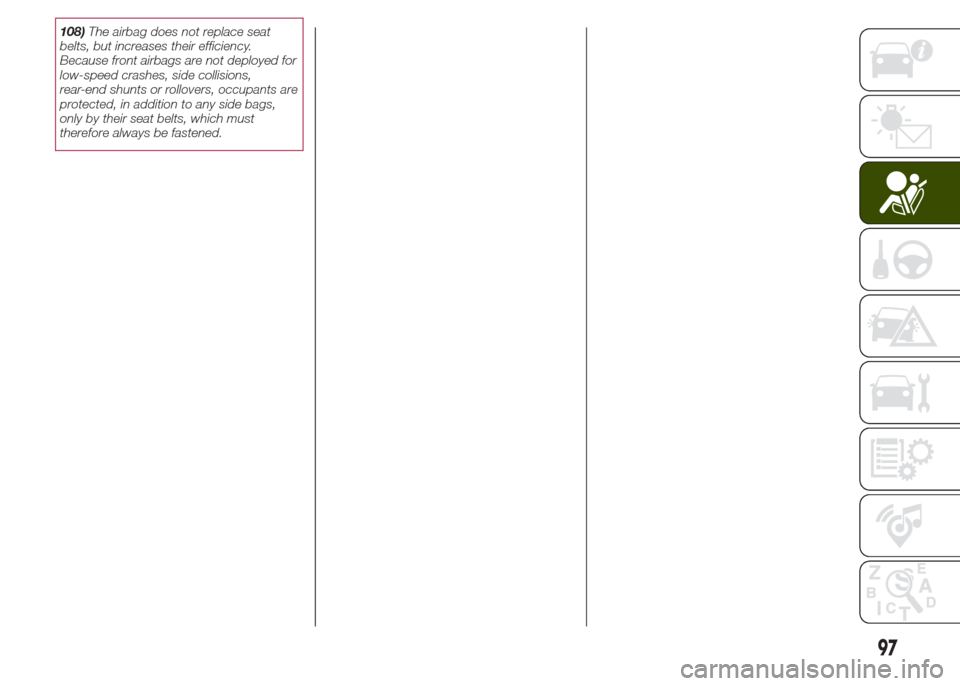
108)The airbag does not replace seat
belts, but increases their efficiency.
Because front airbags are not deployed for
low-speed crashes, side collisions,
rear-end shunts or rollovers, occupants are
protected, in addition to any side bags,
only by their seat belts, which must
therefore always be fastened.
97
Page 100 of 212
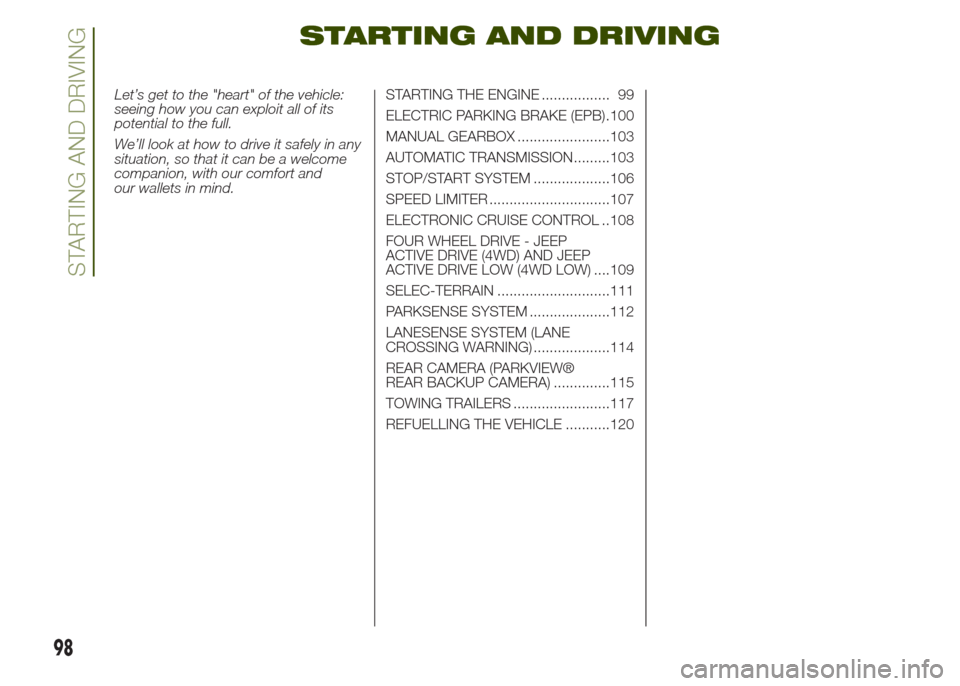
STARTING AND DRIVING
Let’s get to the "heart" of the vehicle:
seeing how you can exploit all of its
potential to the full.
We’ll look at how to drive it safely in any
situation, so that it can be a welcome
companion, with our comfort and
our wallets in mind.STARTING THE ENGINE ................. 99
ELECTRIC PARKING BRAKE (EPB).100
MANUAL GEARBOX .......................103
AUTOMATIC TRANSMISSION.........103
STOP/START SYSTEM ...................106
SPEED LIMITER ..............................107
ELECTRONIC CRUISE CONTROL ..108
FOUR WHEEL DRIVE - JEEP
ACTIVE DRIVE (4WD) AND JEEP
ACTIVE DRIVE LOW (4WD LOW) ....109
SELEC-TERRAIN ............................111
PARKSENSE SYSTEM ....................112
LANESENSE SYSTEM (LANE
CROSSING WARNING) ...................114
REAR CAMERA (PARKVIEW®
REAR BACKUP CAMERA) ..............115
TOWING TRAILERS ........................117
REFUELLING THE VEHICLE ...........120
98
STARTING AND DRIVING